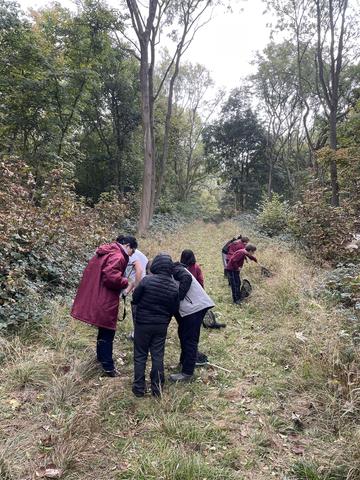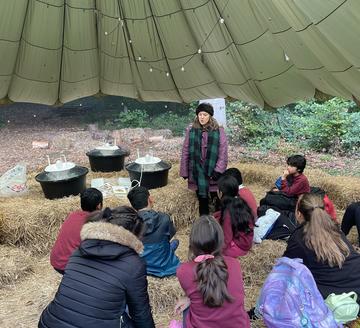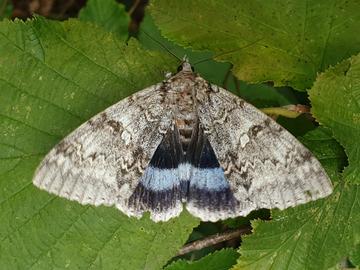BugBlitz! Primary school workshops in biodiversity at Wytham Woods
A Darwin Tree of Life Public Engagement Project

The Darwin Tree of Life (DToL) project has an ambitious target of sequencing the DNA barcodes and full genomes of all complex life across the UK and Ireland (70,000 species of animals, plants, fungi, and protists). It is a collaboration between biodiversity, genomics and analysis partners that is transforming the way scientists do biology, conservation and biotechnology. DToL is the UK’s contribution to the Earth Biogenome Project (a global effort to map the DNA of all complex life) and a collaboration between world-leading scientific institutions, led by the Wellcome Sanger Institute. Public engagement is an integral part of this ambition.
With Wytham Woods being heralded as one of the most researched pieces of woodland in the world due to its abundance of flora and fauna, it was an obvious hub for the University of Oxford’s BugBlitz public engagement project. The aims of BugBlitz are multifaceted; to inspire scientists and conservationists of the future, to imbue in children a respect and understanding of the importance of insect life, to promote connections between researchers and primary school children and to weave aspects of the primary science curriculum into an inspiring and fun learning experience.
This October, I was fortunate to spend a day at Wytham Woods with Cutteslowe Primary School for their BugBlitz workshops:

Shortly after 9 o’clock the 28-strong class of children arrived by coach, ready for an exciting day of discovery. It was raining, but that did not dampen anybody’s spirits as the Year 5s and 6s, along with three teachers and Katie Whale (schools liaison and BugBlitz coordinator), set off up to the Wytham Chalet. Here, they would spend the day learning about insects in three different sessions: a microscope session, led by Katie; a moth session, led by Dr Liam Crowley (currently working on the Wytham Genome Project, part of the Darwin Tree of Life project); and a bug hunting session, led by Natalie Duffus (a DPhil student in the Community Ecology Research Oxford group). BugBlitz is an incredible opportunity for primary school students to get interested in science, insects and nature in a hands-on, fun-filled way, as well as giving Wytham a chance to recruit some future scientists!
In Katie’s microscope session, the young scientists learned about classification of insect species. When asked to guess just how many individual species of insect there are in the world, guesses ranged from 74 at the low end, to over 5 million at the high end. Currently, we know of over 1 million insect species, but the Royal Entomological Society estimates that there may be as many as 10 million. The children also contemplated why it is necessary for scientists to classify insects into the 200 different orders. Then, it was explained that they would be able to examine several insect specimens using microscopes with the goal of identifying to which of the ‘Big 5’ insect orders their specimens belonged. First, they learnt how to focus the microscope in order to examine the natural, woodland items (leaves, acorns, feathers etc.) they had found on their way to the Chalet, and then they were each given an insect to study under the microscope. Finally, the children classified their specimen using a dichotomous key, which is used to identify organisms based on a series of choices between two alternative characteristics. I was impressed with the young scientists’ maturity in understanding that the insects they were using had been killed very humanely and that sometimes things like this are necessary for science.

In Natalie’s bug hunting session, pupils learned about adaptation, and how insects evolve to survive in their environments. Natalie discussed the use of natural camouflage which enables insects to hide from predators. They then explored the woods around the Chalet, looking at all the different habitats for bugs that they could find, including long grass, leaves, log piles, moss, and hay piles. It was great to see the children interacting with nature, and they all found it exciting to use the bug nets and microscope pots to collect the insects that they found. Some of the insects that pupils discovered included woodlice, beetles, moths, spiders, centipedes, and parasitic wasps. Parasitic wasps, our young scientists were shocked to discover, lay their eggs inside other creatures. There was a lot of enthusiasm among the group to get out and explore the woods, and a surprising lack of squeamishness about the prospect of getting up close and personal with real, living, insects.
The enthusiasm and joy that was felt throughout the day continued during Liam’s moth session. Liam showed the group how a moth trap works, using a bright bulb to attract the moths and a funnel to capture them. Then, empty egg cartons are placed inside the trap to give the moths somewhere to hide while they are in the trap. These traps had been laid out the night before the group arrived, so when it was time for our young scientists to have a look, they were filled with an abundance of diverse moth species. The group were then able to get a closer look at all the moths that had been caught as Liam removed them from the trap and put them in specimen pots. The highlight of the session was discovering that the moth trap had caught a Blue Underwing moth, a rare and exceptionally beautiful moth. Pupils were given moth identification guides and were tasked with identifying the moth species that had been caught in the moth traps. Finally, pupils had the opportunity to exercise their creativity as they sketched their favourite moth. Watching children handle and gently release their moths at the end of the session was a really special moment.
After the three sessions, as the young scientists walked back down to the bus from the Chalet, it was clear that the day had been an unmitigated success. The children had learned a huge variety of new things and had experienced nature and science in a whole new way. It is massively important for children to have the opportunity to learn outside of a classroom environment, and BugBlitz has shown the remarkable difference even one day can make. Children that started the day unenthusiastic or terrified of bugs ended it excited to show off all the new things they had learned. The teachers, too, were filled with a renewed appreciation for the importance of Forest Schools and enthusiasm to help children stay connected with nature. Overall, the most important thing about BugBlitz is that everyone who takes part finishes their day more knowledgeable of and curious about the insect world around them – and the value that stems from that is immeasurable.
Reported by Charlotte Knight, with photos and information from Katie Whale
|
Additional information |



